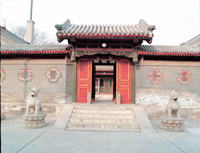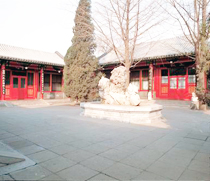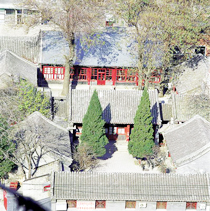Siheyuan
 Dwelling compounds or quadrangles (Siheyuan) in Beijing are one important aspect of the city's architectural heritage.
Dwelling compounds or quadrangles (Siheyuan) in Beijing are one important aspect of the city's architectural heritage.
Beijing's dwelling compounds are generally rectangular, with the four sides squarely facing the cardinal points. Almost every dwelling compound is surrounded by high walls, with an open courtyard in the centre. The buildings on four sides are usually one storey high.
Stepping over the high wooden base of the front gate of a large compound, you will find a brick screen located a few feet inside. In front of the screen is the outer courtyard, which is flanked by structures to the east and west. In former days, these were the kitchen and servants' living quarters. A red-painted gate leads through the north wall of the outer court into the inner courtyard. The main building faces south to get the maximum possible sunshine in winter, and the eaves provide a pleasant shade in summer when the sun is high.
 The building is divided into three or five rooms: living or community rooms in the centre with smaller bedroom or studies at each end. The buildings facing east and west on each side of the court were constructed to accommodate married children and their families. Some dwelling compounds consist of several courtyards. With no steel or concrete, the entire dwelling was built of bricks and wood. The compounds are quiet, beautiful and compact. Beijing residents like to live in them and even foreigners find them attractive.
The building is divided into three or five rooms: living or community rooms in the centre with smaller bedroom or studies at each end. The buildings facing east and west on each side of the court were constructed to accommodate married children and their families. Some dwelling compounds consist of several courtyards. With no steel or concrete, the entire dwelling was built of bricks and wood. The compounds are quiet, beautiful and compact. Beijing residents like to live in them and even foreigners find them attractive.
Nowadays, these peaceful Siheyuan are hard to find in Beijing. The reasons are as follows:
 Since 1949, a large-scale construction programme has been carried out in the city, causing the demolition of some dwelling compounds.
Since 1949, a large-scale construction programme has been carried out in the city, causing the demolition of some dwelling compounds.
During the initial post-liberation period, government offices occupied some Siheyuan. Later they were demolished to build office buildings.
During the "Cultural Revolution" (1966-1976), air-raid shelters were dug everywhere in Beijing, resulting in the destruction of some dwelling compounds.
In recent years many residential buildings have been constructed to ease the housing shortage and provide better accommodation for the people. Some were built on the sites of demolished dwelling compounds. Outer compounds have been changed or distorted beyond recognition because the residents have added kitchens in the courtyards.
Today, Beijing still has about 400,000 residential Siheyuan, mainly distributed over the East, West, Xuanwu and Chongwen districts of the city. Those in the East and West districts are in the best shape. The departments concerned with the preservation of cultural relics in Beijing have earmarked a number of good-quality dwelling compounds for protection. In addition, the urban construction departments have worked out a plan to limit high buildings in the city proper to protect the dwelling compounds.

